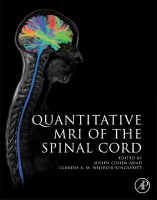Physical Address
304 North Cardinal St.
Dorchester Center, MA 02124

3.1.1 Principles of Diffusion-Weighted Magnetic Resonance Imaging 3.1.1.1 Basic Concept of Diffusion Weighting Water molecules in tissue undergo Brownian motion, which means that molecules are not perfectly static over time but experience random microscopic displacements due to thermal agitation. This…

2.4.1 Background 2.4.1.1 Importance of High Field In the early 1980s, magnetic resonance imaging (MRI) was introduced into clinical practice and has subsequently undergone technical advancements that have resulted in improvements in image quality. For nearly 20 years, 1.5 T…

2.3.1 Introduction: Sources of Susceptibility Artifacts The uniformity of the B 0 main field in magnetic resonance imaging (MRI) is critical for artifact-free image formation. MRI scanners are manufactured with a stringent requirement of less than one part-per-million (ppm) a…

Acknowledgments The author is very grateful to Susann Boretius, Martin Busch, Yasar Goedecke, Martin Koch, Joost Kuijer, Marco Lawrenz, and Petra Pouwels for helpful discussions and to Joachim Graessner (Siemens Healthcare) and Jürgen Bunke (Philips Healthcare) for providing information about…

2.1.1 Introduction Essential parts of a magnetic resonance imaging (MRI) system, radiofrequency (RF) coils or antennas are used to transmit and/or receive signal. Phased-array coils combine multiple small coil elements to transmit or receive signal using independent channels. Array coils…

1.3B.1 Introduction The introduction of magnetic resonance imaging (MRI) to the field of spine trauma has vastly improved the clinical diagnosis of spinal cord injury (SCI). MRI has advantages over conventional X-ray and computer tomography (CT) as it more precisely…

1.3A.1 Introduction Prior to the 1980s a diagnosis of trauma to the spinal cord was largely inferred based on either X-rays showing misalignment of the spinal column or myelography whereby interruption of the flow of contrast medium in the cerebral…

1.2.1 Introduction The spinal cord is a common site of involvement in inflammatory demyelinating diseases of the central nervous system (CNS). The most common such disease, multiple sclerosis, is the leading cause of nontraumatic disability in young adults, with an…

1.1.1 Introduction Neuroaxonal injury of the spinal cord occurs in a broad spectrum of clinically and pathologically heterogeneous neurodegenerative diseases, typically with serious clinical consequences for patients. Typically, the clinical syndrome produced by injury to the spinal cord includes weakness…